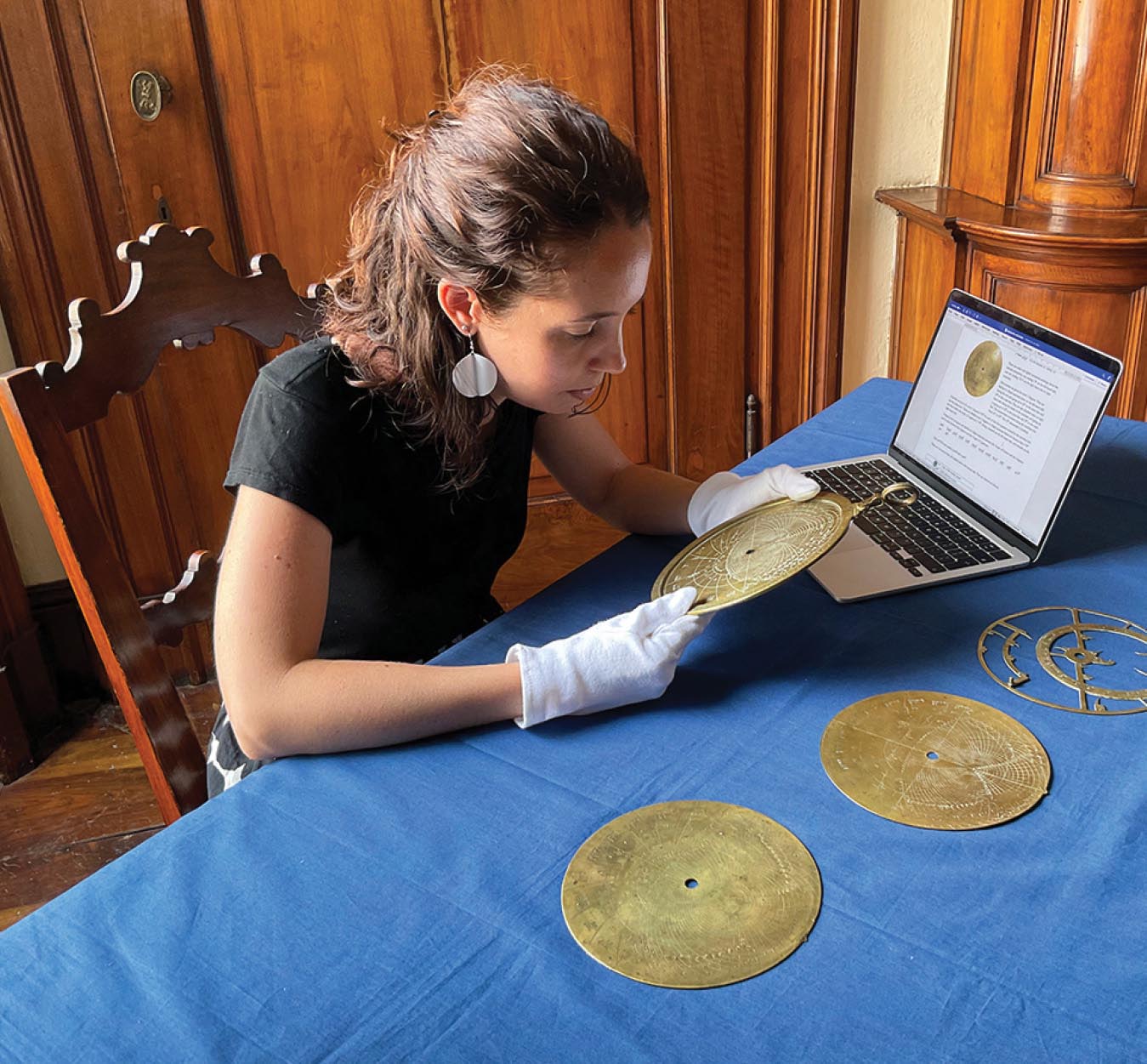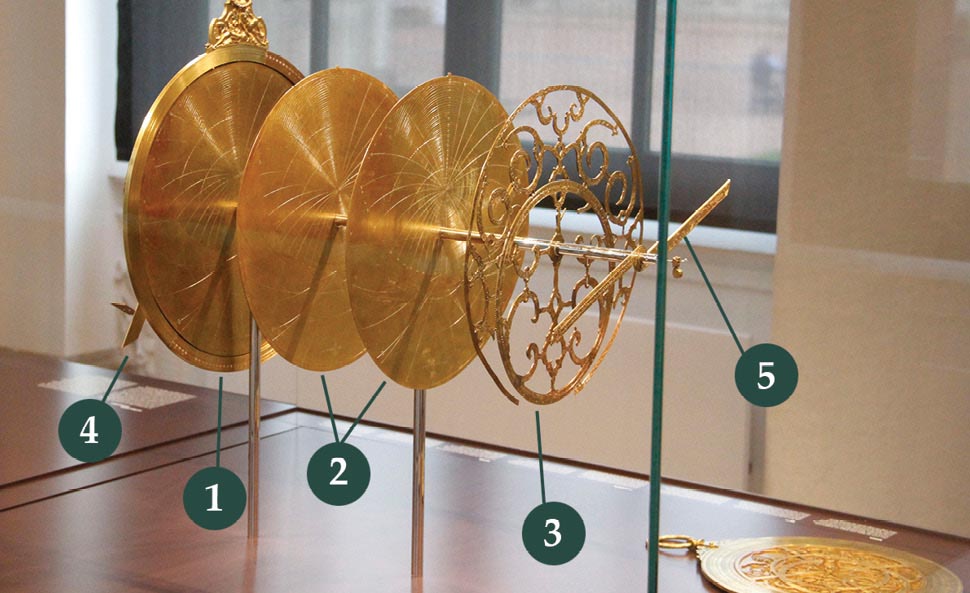The many lives of an 11th-century astrolabe
DOI: 10.1063/pt.pxpg.zlta
It started, as internet diversions often do, with a Google search. Art historian Federica Gigante was preparing a lecture last year when a search for one 17th-century art collector, Ludovico Moscardo, happened to return an image of Moscardo’s collection. Looking closely, Gigante spotted “something that looked like an astrolabe,” an astronomical device often used for timekeeping that was developed in antiquity but is associated primarily with the medieval Islamic world.
The find piqued the interest of Gigante, whose work at the University of Cambridge focuses in part on astrolabes and other Islamic astronomical instruments. After receiving photos of the device from the curator of a museum in Verona, Italy, Gigante went to examine the astrolabe in person (in part, she confesses, because she wanted an excuse to visit her parents).

Federica Gigante examines the 11th-century astrolabe. She is holding the mater, or base disk. Visible on the table are the two removable plates and the mesh-like rete.
FEDERICA CANDELATO

It was a fortuitous decision. As Gigante reports in the March issue of Nuncius, a journal devoted to the material and visual history of science, the medieval instrument contains not only Arabic-language inscriptions but also markings in Hebrew and of Western Arabic numerals.
At first glance, the Arabic-inscribed astrolabe at the Museum of the Miniscalchi-Erizzo Foundation did not look out of the ordinary to Gigante. The devices, described in the box above, were widely produced throughout the medieval era by Muslim artisans because the five prayer times mandated by the Koran are determined by the position of the Sun at a specific latitude. Then she noticed the scratches. It’s not unusual for a medieval object to be scuffed up, but what was strange was how the markings were distributed: “Scratches have a randomness to them that these didn’t have,” says Gigante.
The breakthrough came when she found a clear Hebrew inscription on one of the plates that spelled out the equivalent of the adjacent Arabic text. Gigante started looking at the other scratches with the assumption that they were Hebrew letters and realized that they, too, were transliterations of Arabic. Closer examination revealed that the astrolabe contains two sets of Hebrew inscriptions and a series of Western Arabic numerals, the kind we use today, that translate the alphabetical Arabic numerals in the original text.
An astrolabe can be dated using the star pointer on its rete, the mesh-like rotatable plate that sits atop the device, because the combination of stars’ proper motions and Earth’s axial precession gradually shifts the positions of stars in the night sky. Gigante finds that the Verona astrolabe depicts the sky as it was in the late 11th century. Arabic inscriptions on the astrolabe’s mater, or base, and on one of its two plates refer to the Spanish localities of Cordoba, Toledo, and Medinaceli. That implies that the astrolabe was made in the historical region known as al-Andalus—the portion of present-day Spain and Portugal that was ruled by Muslim states from 711 to 1492 CE.
Astrolabe 101
Astrolabes consist of five key parts:

A disassembled astrolabe at the Royal Cabinet of Mathematical and Physical Instruments in Dresden, Germany. (Labels added to original.)
ELROND/WIKIMEDIA COMMONS/CC BY-SA 4.0

A base disk known as the mater, meaning mother in Latin. It contains markings on its rim that indicate hours of time or degrees of arc.
One or more swappable plates. Each plate depicts a 2D projection of the sky at a certain latitude.
A mesh-like top called the rete, meaning net or web in Latin. It contains a ring that marks the ecliptic and multiple pointers that identify the location of specific stars in the night sky.
The alidade, derived from the Arabic word for ruler. The rotating bar is attached to the back of the mater with sights on each end through which the user locates the Sun or stars.
The rule, a rotating bar on the front of the astrolabe that can locate positions on the rete or plates.
Assuming that they knew their latitude and the day of the year, astrolabe users could determine the time of day by sighting the Sun or a star with the alidade and reading the markings on the mater’s rim. Astrolabes were used not only for timekeeping but also for other reasons, such as locating constellations.
An inscription on the back of the astrolabe mentions the names Ishāq and Yūnus, the Arabic translations of the traditional Jewish names Isaac and Jonah. Gigante posits that the astrolabe passed at one point into the hands of al-Andalus’s Arabic-speaking Sephardic Jewish community. She suggests that the two sets of Hebrew inscriptions were added once the astrolabe was in Italy, where the Jewish community did not speak Arabic, and that the Western Arabic numerals were added even later by someone who spoke a Romance language.
A few other known Arabic-language astrolabes have had Hebrew inscriptions added, Gigante says. But the Verona instrument stands out because of the sheer number of users who modified it—she counts at least six—and the presence of the Western Arabic numerals.
The intermingling of cultures implied by the inscriptions would not have been all that surprising to contemporaries. Although the medieval and early modern periods in the Mediterranean region saw plenty of conflict between Islamic, Christian, and Jewish populations, lengthy periods of peace and religious tolerance also occurred. Moreover, even the periods of conflict were characterized by dynamic cultural exchange. Although the craftsman who made the astrolabe was undoubtedly Muslim, it’s possible that the device was never used by followers of the Islamic faith. “The first owner,” says Gigante, “could very easily have been Jewish.”
A version of this story was originally published online on 29 March 2024.
More about the Authors
Ryan Dahn. rdahn@aip.org

